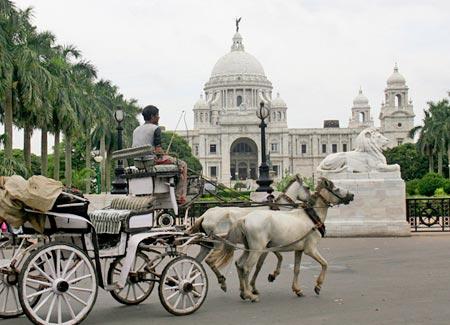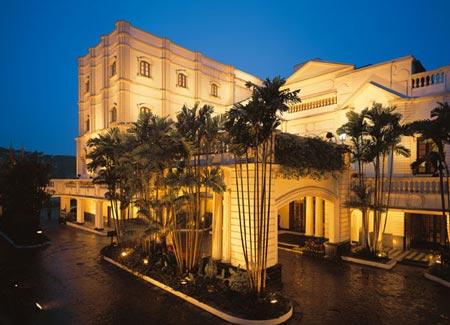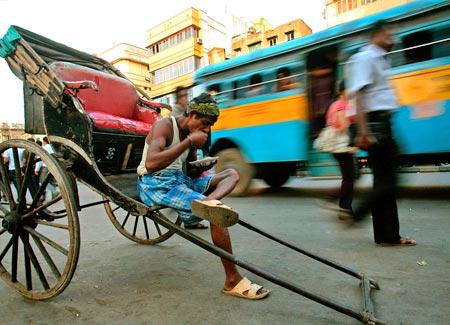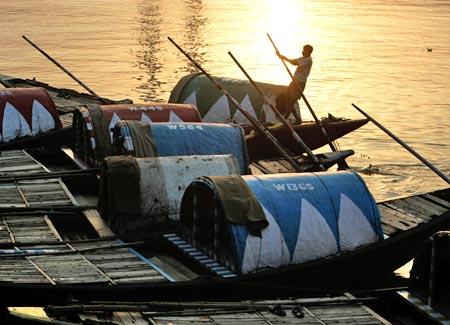 | « Back to article | Print this article |
Discovering Kolkata today
"What a weird dog," said a stalwart travelling buddy of mine as our taxi curved around the driveway of the Tollygunge Club.
Something piebald and mangy stood at the edge of a putting green.
"I don't think that's a dog at all," I replied, peering past the driver. "I think it's a fox."
Whatever it was cocked its snout and swivelled its pointy ears, nostrils quivering to scout our scent.
In the backseat, our novelist friend Susanna craned her neck as the taxi approached the clubhouse's porte coch re. She nonchalantly leaned forward and said, in a way that this particular pal has of making uncanny things sound matter-of-fact: "Oh, that's not a fox. It's a jackal."
Of course it was. Aren't there jackals in the suburbs of every major metropolis, loping around the golf course and skittering onto the runways at the international airport to shut down flights? (This has actually occurred.) We were in Calcutta (or Kolkata, to use the official name) and it was getting toward the hot season and the curious occurrences were only bound to get curiouser.
We had come into town, my travelling friend and I, a few days before from the Indian back-of-beyond. Upon our arrival we learned from the Telegraph, Kolkata's daily newspaper, that we were in for a day unlike any "ever before seen in our lives." An astronomical confluence would result in Good Friday, the natal day of the Prophet Mohammed, and the big Hindu festival of Holi occurring simultaneously.
"It is extremely rare that three events of different religions fall on the same day," a spokesman for the All India Federation of Astrologer's Societies said on the radio. His unctuous tone put me in mind of Constella of the Daily News, an astrologer on the radio when I was a kid. "The stars guide," an announcer used to say when introducing Constella, his voice reverberating as if he were talking through the wrong end of a megaphone. "They do not govern. Your life is largely in your own hands."
That notion is loopy, of course, and never more so than in India, where anyone deluded enough to imagine that fate is theirs to decide will soon be persuaded otherwise. An old Hindi adage points out that in India, there are seven days in a week -- but eight religious festivals ("Saat vaar aur aath tyohaar"). This is one piece of local wisdom that, it strikes me, is worth keeping in mind.
It's not that I had outsize ambitions for this visit. Kolkata is not renowned for throwing travellers a welcome mat. More than any Indian place of my acquaintance, this alternately tony, intellectual, and legendarily squalid Bengali city expects to be taken at its own pace and on its own terms, and that was fine with me.
Still, had the hotel been any other, it might have felt like misfortune to land in a city when everything was half shuttered in anticipation of a big holiday. But my friend and I put up at the Oberoi Grand, and few lodgings are more accurately named. Like Claridge's in London or (at one time) the Plaza in New York or the Taj Mahal in Mumbai, the Grand has been a source of civic pride and a landmark of social arrival for more than a century. A vast block-long pile at the heart of the city's main thoroughfare, Jawaharlal Nehru Road (formerly Chowringhee Road), the Grand is equal parts fortress, mansion, and society bastion, the kind of place where anyone who has ever been anyone in the city has been proud to let you know they are lodged.
Period photos show Chowringhee Road as a broad European boulevard, but a snapshot taken now would tell a different tale. In place of the sahibs in natty straw hats and ladies in starched linen are teeming crowds sheltering beneath the hotel's covered colonnade. That street-facing fa ade is now a market where refugees from the poor Indian state of Bihar set up shop daily on militarily contested patches of ground. Each morning they unroll bundles of T-shirts, cheap wallets, batteries, plaster birds, paperbacks, and handmade gizmos and set about advertising the superiority of their wares at pain-level volume until well after dark.
Its pleasures, like its citizens, take time to know
Discordant juxtapositions, let's face it, are nothing new in India and no novelty, either, to the foreign audiences that crowded into Slumdog Millionaire. At the Oberoi Grand, a guest slips in an instant from tumult into a hushed security. Even before November's terrorist attacks in Mumbai, the transition from the hubbub of the pavement into the enveloping safety of the hotel (armed guards pass mirrored wands under the chassis of each incoming vehicle) was welcome, largely because the greatest luxuries in India are private space and a place to escape the insanity of the street.
Not that Kolkata is a maelstrom. Yes, there is plenty to deplore. But one could say the same of Detroit. Unlike Kolkata, however, Detroit was never known as the City of Palaces and it does not possess the marbled texture of urban nougat, studded and veined and patterned with the strange and wonderfully accreted remnants of centuries.
One may not visit Kolkata to tick landmarks off an imaginary life list. And unlike, say, Delhi, where the remnants of ancient dynasties lie jumbled atop one another in landscapes that read like palimpsests, it more closely resembles a crumbling South Asian version of a Victorian industrial centre. Its pleasures, like its citizens, take time to know. But it is, for India, an unusually good place for a walker, abundantly supplied with the decayed civic furniture of the British Raj. And the food is justly celebrated, as anyone knows who has ever tucked into a plate of yellow lentils and the river fish called begti at Kewpie's Kitchen, a landmark restaurant in the southern part of town.
The Indian Museum there, the country's largest, is a vast and stolid colonial edifice full of unheralded oddities and treasures hidden in plain sight. On the morning of the day after our arrival I took an extremely pleasant stroll to the museum along Jawaharlal Nehru Road, which was just waking up, the fruit vendors and chai wallahs bustling around to set up their stalls by the curb. Paying my $3 admission, I entered the museum and found, to my pleasure, that I had it almost to myself.
My main accompaniment was the noisome gossip of the local mynahs, which kept up a running conversation in the museum's interior courtyard as I mooched contentedly along, from spaces full of first- to third-century Gandharan friezes to rooms where cases held items like a pair of women's iron bangles -- recovered, a label explained, from the intestines of a crocodile.
Another morning I made a pilgrimage to the tumbledown Marble Palace, in North Calcutta, built during the 19th century by the trader Raja Rajendra Mullick to accommodate a strange hoard of Chinese urns and ornate statues of naked European ladies and pictures allegedly by Rubens and Murillo, whose paint now flakes and whose canvases sag in their frames.
Feeling a bit weighed down by the place, I exited the palace and went walking in its scrubby gardens, where stood the rajah's aviary and the wood-caged remnants of what must have once been an impressive menagerie. For a time my attention was so absorbed by the morose Bengal porcupine and some molting pied hornbills that I failed to notice a large, wild-eyed monkey advancing along a pathway until it was almost on top of me.
I hotfooted it out of there and spent the rest of that day threading the labyrinth of roofed lanes inside the dusty colonial-era New Market (or, rather, its replica; the 19th-century original burned in 1985) behind the Oberoi Grand, shadowed all the while by a man whose official badge identified him as a coolie.
It is probably worth noting here that, like the existence of barefoot rickshaw pullers in the streets, the presence in Kolkata of anachronisms like coolie is troubling in light of the city's preening new status as a booming tech hub, home to a sophisticated and highly educated middle class. Last year, for instance, the city donated six acres for the creation of a contemporary-art museum to be designed by Herzog & de Meuron, architects of London's Tate Modern. Set to open in 2013, the museum will be anchored by holdings amassed by some of India's new art-infatuated superrich.
These types may share the air of Kolkata with the tout who trailed me past vendors of jasmine garlands, plastic flip-flops, and bolts of sari cloth, but it goes without saying that such people inhabit a universe very distant from his. My tout steered me forcefully away from my stated goal (the Tibetan antiquarian shop Chamba Lamba) and toward stalls operated by Kashmiri vendors, where my charitable purchase of a $5 pashmina would bring him that much closer to his kickback, the fake Rolex of his dreams.
'That's what Mother Teresa is for'
It happened that, conducted by friends or else carrying letters of introduction from the hotel, we were able to visit some of Kolkata's private clubs, which was how we happened to find ourselves wandering the empty golf course at the Tollygunge one hazy afternoon, eyes peeled for the jackals that, I learned later, are a routine hazard on the fairways.
We had afternoon tea on the lawn of the Saturday Club, watched a cutthroat game of indoor badminton, and, on another day at another club, were served fish croquettes by a doddering ancient wearing frayed cotton gloves and a lopsided turban.
On one of these outings I asked an acquaintance for help making sense of the distortions of a city where, from the window of the car ferrying us from the airport, I spotted a man asleep on a median, naked and barely recognizable as a member of human society. She gave me an indulgent look Indians tend to reserve for foreigners who come to Kolkata seeking easy explanations or cheap profundity.
"There are missions for that," another acquaintance remarked when I posed the same question to her. Kolkata is full of them, she added, and of missionaries happy to distribute one's largesse. "That's what Mother Teresa is for," she added, and it was admittedly a relief to acknowledge that better and worthier people than I stand ready to take on tasks that, given a thousand lifetimes, I could not.
Why falsify things? Or why do so in Kolkata, where realism can be voiced in a tongue as lashing as that of Kali, the ghoulish deity locally venerated for her bloodlust and rapacious appetites? It probably says a certain amount about a place that its presiding goddess is usually pictured enwreathed in flames and wearing a garland of skulls. Kali, the destroyer, the insatiable, devours her enemies in a cavernous maw; in her tantric form, she is commonly depicted squatting atop the corpse of Shiva in an act of unseemly posthumous carnality.
An old friend I had unexpectedly run into at the hotel's breakfast buffet consented to join me for an outing to the famed Kali Temple on an imposingly muggy afternoon. "In God's name, why?'' another friend, a devout Hindu, asked when informed of our plans. "That temple is the most godless place on earth." At least, she added, avoid the place on sacrifice day, when the paths can be slick with freshly spilled blood.
We went anyway and found a scene that, far from tumultuous or gory, was oddly domestic. Shedding our shoes at the gateway, we fell in behind a few pilgrims shuffling toward a shrine where devotees chanted or else slumped in any available patch of shade. Like everyone else, we paused at the door of the sanctum, peering intently at an idol that looks much smaller in real life than in her photographs, the way movie stars do.
Trailing the crowd through to what looked like an exit we found ourselves instead in an adjacent temple dedicated to Shiva, Kali's erstwhile lover. Not unusually for such places, we were soon accosted by a Brahman priest. Knotting an auspicious thread around my friend's wrist, the priest whispered that 1,000 rupees was the customary temple donation. The figure, he went on, was barely enough for a bag of rice with which to feed the starving local populace. Being relatively new to temple scams my friend gamely forked over the cash.
Then it was my turn. The priest rewound his spiel, first favouring me with a smile of oily insincerity rarely seen outside a Jerry Lewis telethon. Ignoring his scandalized look when I did so, I handed him a more customary 100 rupee note (about $2) and remarked that, if rice was going for $20 a bag in these parts, he should get out of the god business and onto the commodities floor.
From the Kali Temple we took ourselves to South Kolkata and the Weavers Studio, easily the most sophisticated textile gallery I know of in India, and wandered around in a daze induced by the wealth of crafts traditions (among other things, India invented block printing, calico, chintz, crewel, and tie-and-dye), and also somewhat sticker-shocked by the price tags on saris of embroidered kantha cloth or shawls of naturally golden silk from Assam.
A ferry ride on the Hooghly
Toward the end of our stay, I went walking in Kumartuli, near the Hooghly River, where about 600 families of traditional idol makers work and live. It is at Kumartuli that countless effigies of Hindu gods and goddesses are constructed from mud dredged from the river bottom and then moulded over frames of bamboo, lath, and straw. Passed from one generation to another, the idol-making craft reaches a pitch of activity in autumn, during the festival of Durga Puja, when gaudy images of the goddess Durga and her daughter Saraswati, tarted up with glitter, foil, and sequins, are carried to the Hooghly on palanquins and sunk. Or they were, until soggy idols polluted the river-banks to such an extent that officials insisted worshippers fish them back out after immersion.
Other than crossing it on a bridge, we had not seen much of the Hooghly, so we hired a boat to convey us to Belur Math, the campus of the Ramakrishna Vivekenanda wing of Hinduism. The vessel, about the size of a small ferry, carried just the two of us past the Nimtala Ghat, the crematory where a stoned Allen Ginsberg once sat through the night watching the flames consume the dead; by the imaginary demarcation between the old "white" and "black" cities; and beneath the Hooghly Bridge, where hordes from among the 2 million pedestrians who cross the river on foot each day staggered along, each carrying what looked like an armoire on his head.
We landed at Belur Math's temple complex, which is kept unusually pristine by funds from international devotees. We walked around for a while but soon grew bored by the bandbox modernity of the place and spooked by the expressions on the faithful's faces, a familiar smug look that seems to creep over the spiritually assured.
We reboarded the boat and headed south. Suddenly a squall came out of nowhere, the sky went dark, rain pelted, and a chop in the Hooghly caused the boat to list drunkenly to port. More alarming still, the wind pressed smoke toward us from the industrial east shore of the river like an infernal cloud bank, a shroud. Suddenly we were in a scene out of Blake.
At the approach of the storm most people had scattered for shelter. But my eye was caught by the sight of two children laughing and splashing at the water's edge near the burning ghat. If their insouciance struck me as strangely wonderful it may be due to a passage I had read that morning by the 94-year-old Indian writer Khushwant Singh. The miracle of life, Singh wrote, quoting the Mahabharata, is that while we all know death is inevitable, no one truly believes it will come to him. Death is something that happens to other people. Each of us secretly expects to live eternally.
If the kids on the riverbank looked convinced of their own immortality, my own felt substantially less secure. Yet, as suddenly as the storm had begun, it subsided. The turbulent water went flat. I glanced at my watch and realized with surprise that the cosmic convergence had crept up on us. It was Good Friday. It was Holi. It was the Prophet's birthday. It was time for a drink.



